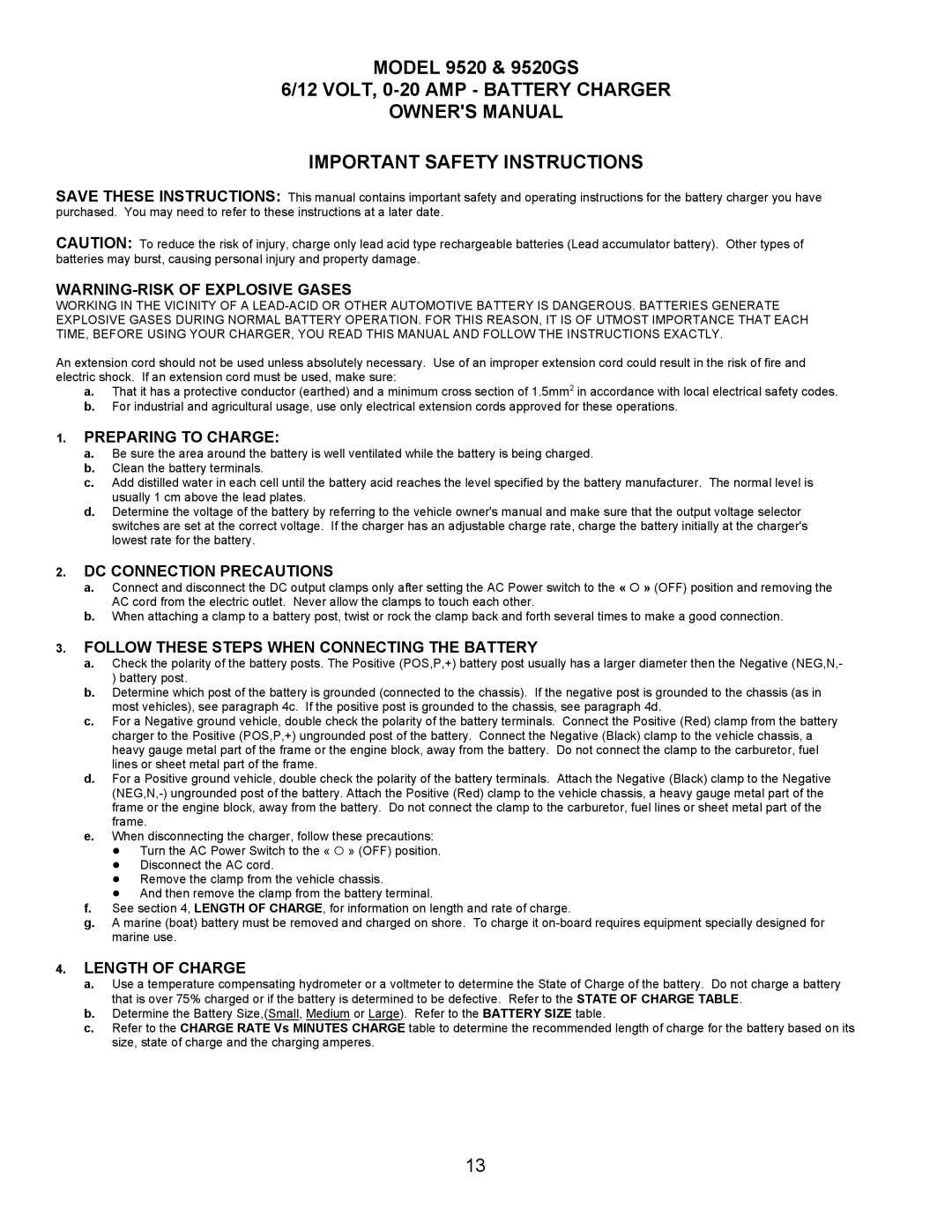MODEL 9520 & 9520GS
6/12 VOLT,
OWNER'S MANUAL
IMPORTANT SAFETY INSTRUCTIONS
SAVE THESE INSTRUCTIONS: This manual contains important safety and operating instructions for the battery charger you have purchased. You may need to refer to these instructions at a later date.
CAUTION: To reduce the risk of injury, charge only lead acid type rechargeable batteries (Lead accumulator battery). Other types of batteries may burst, causing personal injury and property damage.
WORKING IN THE VICINITY OF A
An extension cord should not be used unless absolutely necessary. Use of an improper extension cord could result in the risk of fire and electric shock. If an extension cord must be used, make sure:
a.That it has a protective conductor (earthed) and a minimum cross section of 1.5mm2 in accordance with local electrical safety codes.
b.For industrial and agricultural usage, use only electrical extension cords approved for these operations.
1.PREPARING TO CHARGE:
a.Be sure the area around the battery is well ventilated while the battery is being charged.
b.Clean the battery terminals.
c.Add distilled water in each cell until the battery acid reaches the level specified by the battery manufacturer. The normal level is usually 1 cm above the lead plates.
d.Determine the voltage of the battery by referring to the vehicle owner's manual and make sure that the output voltage selector switches are set at the correct voltage. If the charger has an adjustable charge rate, charge the battery initially at the charger's lowest rate for the battery.
2.DC CONNECTION PRECAUTIONS
a.Connect and disconnect the DC output clamps only after setting the AC Power switch to the « F » (OFF) position and removing the AC cord from the electric outlet. Never allow the clamps to touch each other.
b.When attaching a clamp to a battery post, twist or rock the clamp back and forth several times to make a good connection.
3.FOLLOW THESE STEPS WHEN CONNECTING THE BATTERY
a.Check the polarity of the battery posts. The Positive (POS,P,+) battery post usually has a larger diameter then the Negative (NEG,N,- ) battery post.
b.Determine which post of the battery is grounded (connected to the chassis). If the negative post is grounded to the chassis (as in most vehicles), see paragraph 4c. If the positive post is grounded to the chassis, see paragraph 4d.
c.For a Negative ground vehicle, double check the polarity of the battery terminals. Connect the Positive (Red) clamp from the battery charger to the Positive (POS,P,+) ungrounded post of the battery. Connect the Negative (Black) clamp to the vehicle chassis, a heavy gauge metal part of the frame or the engine block, away from the battery. Do not connect the clamp to the carburetor, fuel lines or sheet metal part of the frame.
d.For a Positive ground vehicle, double check the polarity of the battery terminals. Attach the Negative (Black) clamp to the Negative
e.When disconnecting the charger, follow these precautions:
!Turn the AC Power Switch to the « F » (OFF) position.
!Disconnect the AC cord.
!Remove the clamp from the vehicle chassis.
!And then remove the clamp from the battery terminal.
f.See section 4, LENGTH OF CHARGE, for information on length and rate of charge.
g.A marine (boat) battery must be removed and charged on shore. To charge it
4.LENGTH OF CHARGE
a.Use a temperature compensating hydrometer or a voltmeter to determine the State of Charge of the battery. Do not charge a battery that is over 75% charged or if the battery is determined to be defective. Refer to the STATE OF CHARGE TABLE.
b.Determine the Battery Size,(Small, Medium or Large). Refer to the BATTERY SIZE table.
c.Refer to the CHARGE RATE Vs MINUTES CHARGE table to determine the recommended length of charge for the battery based on its size, state of charge and the charging amperes.
13
